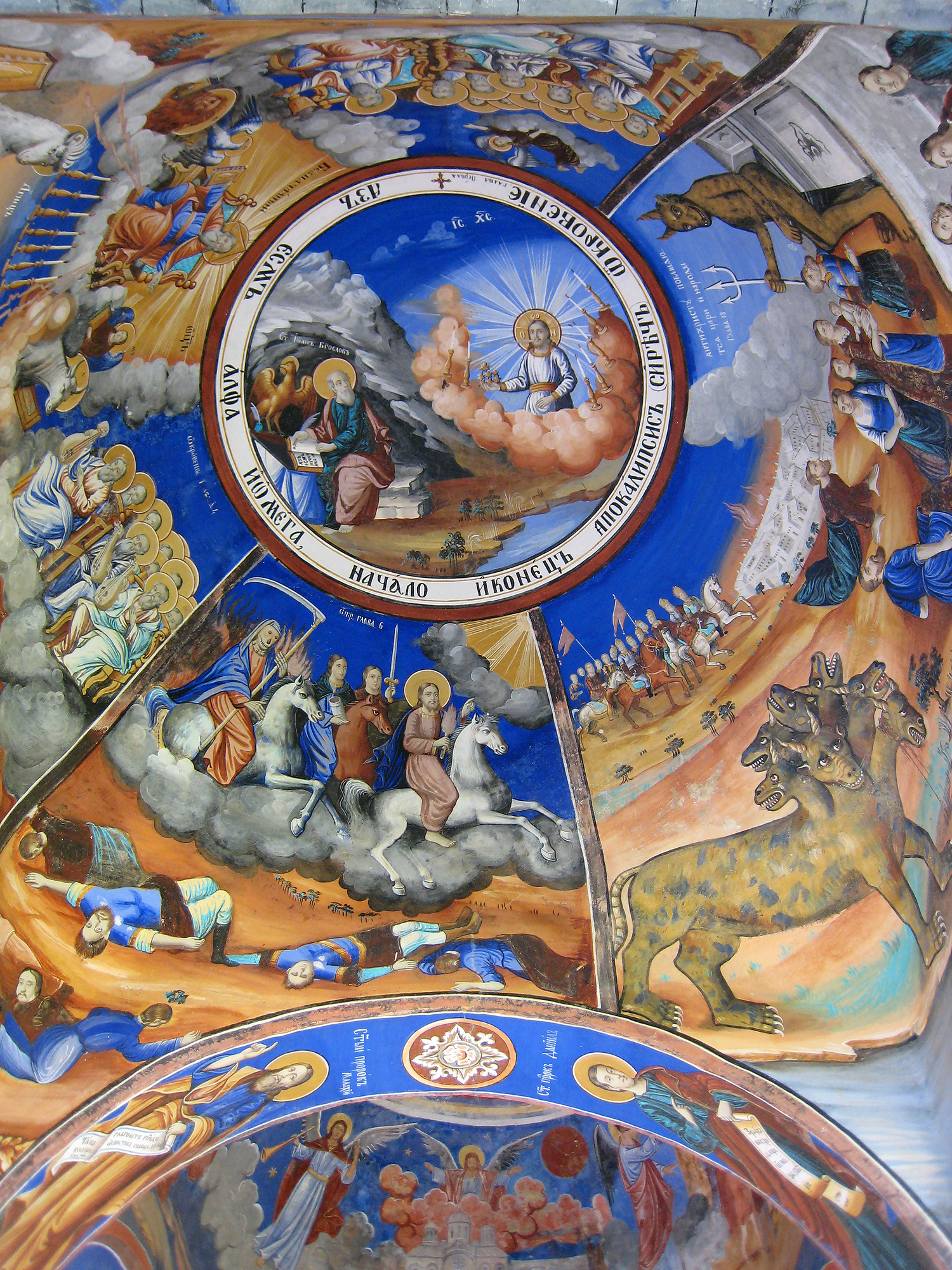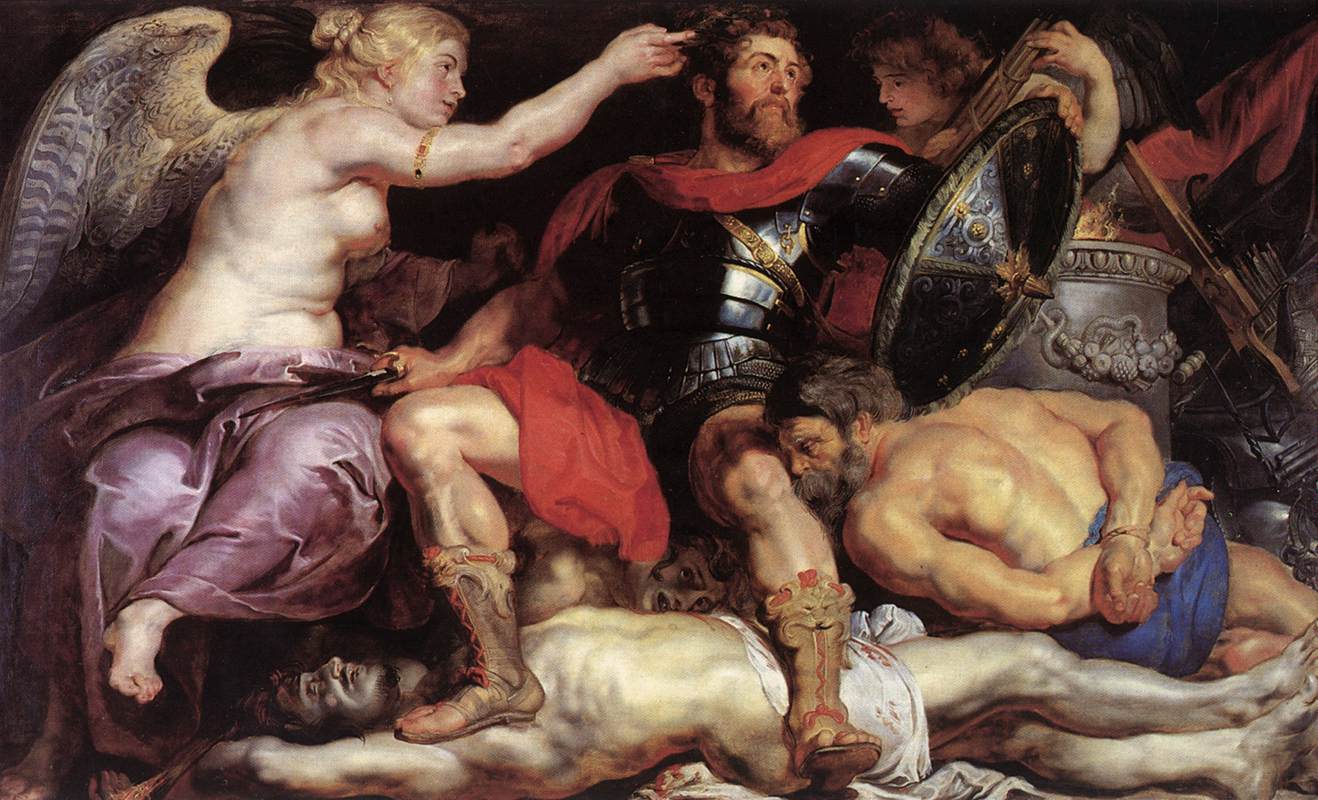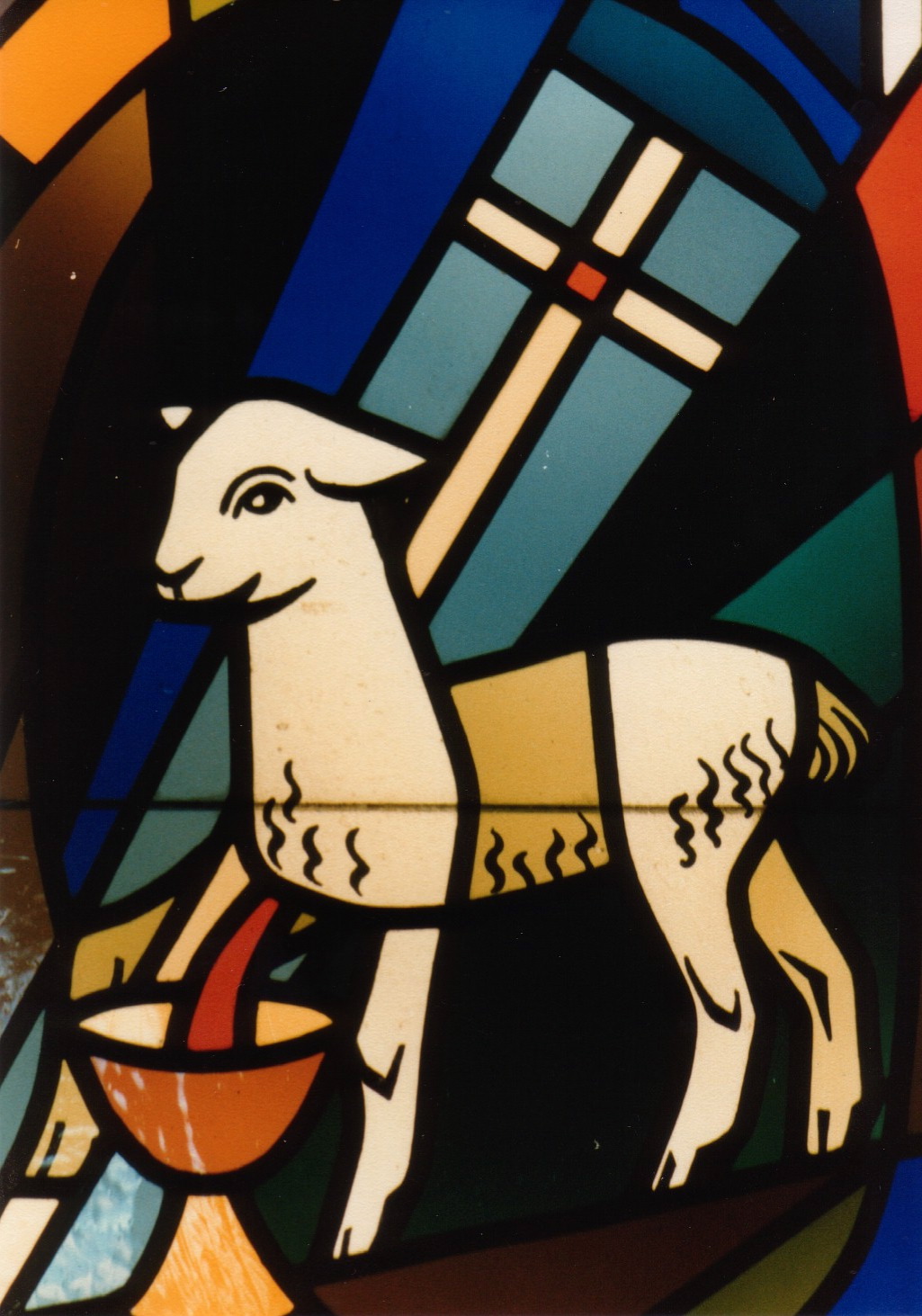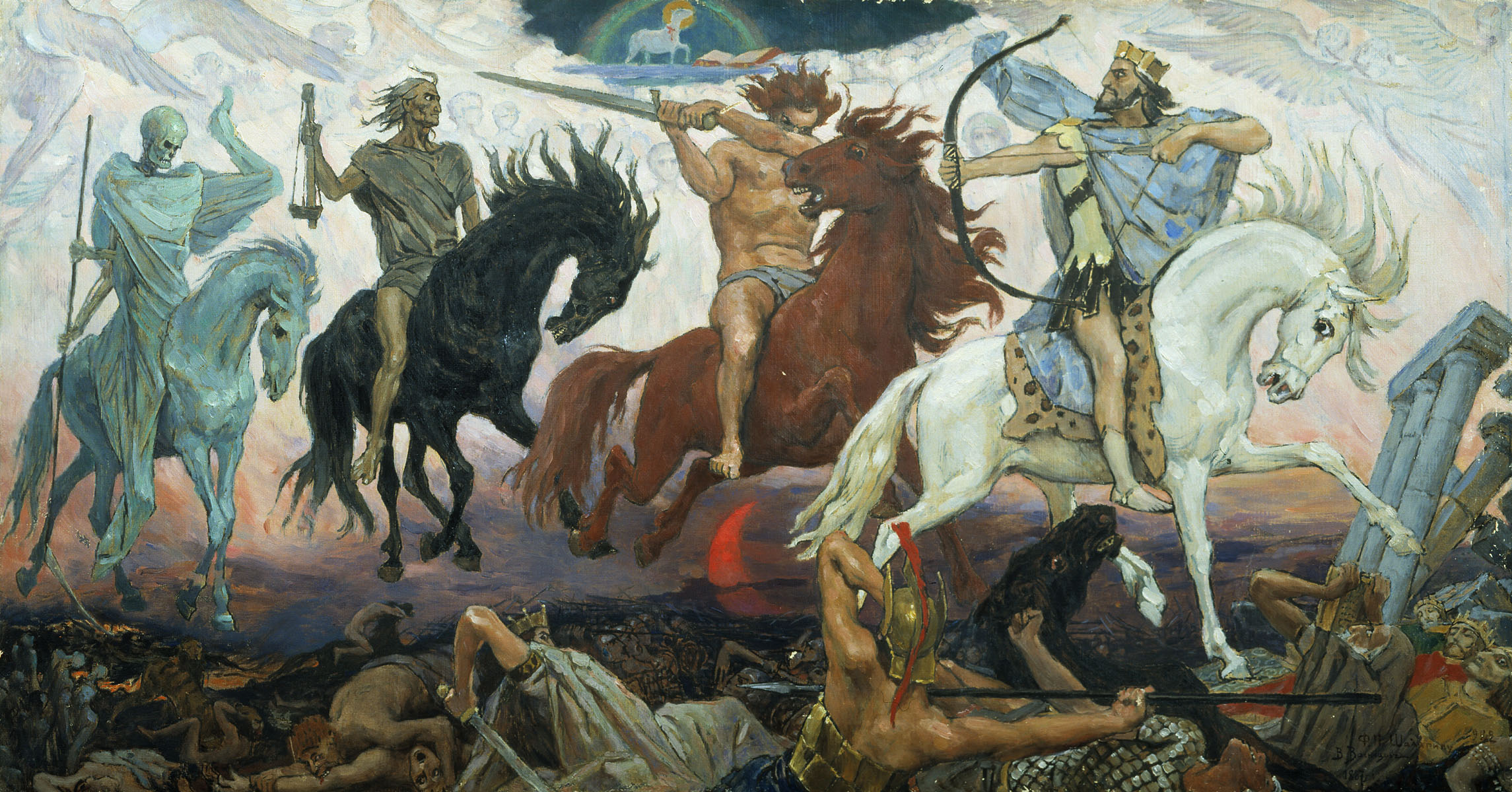|
Four Horsemen Of The Apocalypse
The Four Horsemen of the Apocalypse are figures in the Book of Revelation in the New Testament of the Bible, a piece of apocalypse literature attributed to John of Patmos, and generally regarded as dating from about AD 95. Similar allusions are contained in the Old Testament books of Ezekiel and Zechariah, written about six centuries prior. Though the text only provides a name for the fourth horseman, subsequent commentary often identifies them as personifications of Conquest ( Zelos/ Zelus), War (Ares/Mars), Famine ( Limos/ Fames), and Death ( Thanatos/ Mors or Moros/ Fatum). Revelation 6 tells of a book or scroll in God's right hand that is sealed with seven seals. The Lamb of God/Lion of Judah opens the first four of the seven seals, which summons four beings that ride out on white, red, black, and pale horses. All of the horsemen save for Death are portrayed as being human in appearance. In John's revelation the first horseman rides a white horse, carries a bow, and is ... [...More Info...] [...Related Items...] OR: [Wikipedia] [Google] [Baidu] |
Apocalypse Vasnetsov
Apocalypse () is a literary genre originating in Judaism in the centuries following the Babylonian exile (597–587 BCE) but persisting in Christianity and Islam. In apocalypse, a supernatural being reveals cosmic mysteries or the future to a human intermediary. The means of mediation include dreams, visions and heavenly journeys, and they typically feature symbolic imagery drawn from the Jewish Bible, cosmological and (pessimistic) historical surveys, the division of time into periods, esoteric numerology, and claims of ecstasy and inspiration. Almost all are written under pseudonyms (false names), claiming as author a venerated hero from previous centuries, as with the Book of Daniel, composed during the 2nd century BCE but bearing the name of the legendary Daniel from the 6th century BCE. Eschatology (from Greek ''eschatos'', last) concerns expectations of the end of the present age. Thus, apocalyptic eschatology is the application of the apocalyptic world-view to the end ... [...More Info...] [...Related Items...] OR: [Wikipedia] [Google] [Baidu] |
Fames
In Roman mythology, Fames is the personification of hunger, who can arouse an insatiable appetite. She was often said to be one of the several evils who inhabit the entrance to the Underworld. In Ovid's ''Metamorphoses'', she lives in Scythia, a desolate place where she scrabbles unceasingly for the scant vegetation there, and at Ceres' command, she punishes Erysichthon with a never-ending hunger. Servius calls Fames the greatest of the Furies. She is the equivalent of the Greek Limos. Sources Plautus In '' Stichus'' (200 BC), a comedy by the Roman playwright Plautus, the ever-hungry Gelasimus, in the role of the ''parasite'', one of the stock characters in Roman comedy, describes Fames as his mother: Virgil, Seneca, and Claudian The Latin poets Virgil, Seneca the Younger, and Claudian all list Hunger as among the many evils said to dwell in the Underworld. Describing the approach to the Underworld, Virgil, in his ''Aeneid'', says: Seneca, in his ''Hercules'', says that next to ... [...More Info...] [...Related Items...] OR: [Wikipedia] [Google] [Baidu] |
Antichrist
In Christian eschatology, Antichrist (or in broader eschatology, Anti-Messiah) refers to a kind of entity prophesied by the Bible to oppose Jesus in Christianity, Jesus Christ and falsely substitute themselves as a savior in Christ's place before the Second Coming. The term ''Antichrist'' (including one plural form)First Epistle of John, 1 John ; . Second Epistle of John, 2 John . is found four times in the New Testament, solely in the First Epistle of John, First and Second Epistle of John. Antichrist is announced as one "who denies the Father and the Son." The similar term ''pseudokhristos'' or "false Christ" is also found in the Gospels. In Gospel of Matthew, Matthew (Matthew 24#Jesus predicts the destruction of the Temple, chapter 24) and Gospel of Mark, Mark (Mark 13, chapter 13), Jesus alerts his disciples not to be deceived by the False prophet#Christianity, false prophets, who will claim themselves to be the Christ (title), Christ, performing "great Sign#Christianity, signs ... [...More Info...] [...Related Items...] OR: [Wikipedia] [Google] [Baidu] |
Infection
An infection is the invasion of tissue (biology), tissues by pathogens, their multiplication, and the reaction of host (biology), host tissues to the infectious agent and the toxins they produce. An infectious disease, also known as a transmissible disease or communicable disease, is an Disease#Terminology, illness resulting from an infection. Infections can be caused by a wide range of pathogens, most prominently pathogenic bacteria, bacteria and viruses. Hosts can fight infections using their immune systems. Mammalian hosts react to infections with an Innate immune system, innate response, often involving inflammation, followed by an Adaptive immune system, adaptive response. Treatment for infections depends on the type of pathogen involved. Common medications include: * Antibiotics for bacterial infections. * Antivirals for viral infections. * Antifungals for fungal infections. * Antiprotozoals for protozoan infections. * Antihelminthics for infections caused by parasi ... [...More Info...] [...Related Items...] OR: [Wikipedia] [Google] [Baidu] |
Conquest
Conquest involves the annexation or control of another entity's territory through war or Coercion (international relations), coercion. Historically, conquests occurred frequently in the international system, and there were limited normative or legal prohibitions against conquest. The onset and diffusion of nationalism (the belief that nation and state should be congruent), especially in the 19th century, made the idea of conquest increasingly unacceptable to popular opinion. Prohibitions against conquest were codified with the establishment of the League of Nations following World War I and of the United Nations at the end of World War II. Scholars have debated the strength of a Social norm, norm against conquest since 1945. Conquest of large swaths of territory has been rare since the end of World War II. However, states have continued to pursue annexation of small territories. History Military history provides many examples of conquest: the Roman conquest of Britain, the S ... [...More Info...] [...Related Items...] OR: [Wikipedia] [Google] [Baidu] |
Lion Of Judah
The Lion of Judah (, ) is a Jewish national and cultural symbol, traditionally regarded as the symbol of the tribe of Judah. The association between the Judahites and the lion can first be found in the blessing given by Jacob to his fourth son, Judah, in the Book of Genesis of the Hebrew Bible. It is also mentioned in the Book of Revelation of the New Testament as a term representing Jesus of Nazareth, according to Christian theology. The Lion of Judah was also one of the titles used by Ethiopian emperors from the Solomonic dynasty. History Judaism The biblical Judah (in Hebrew: ''Yehuda'') is the eponymous ancestor of the Tribe of Judah, which is traditionally symbolized by a lion. In Genesis, the patriarch Jacob ("Israel") gave that symbol to this tribe when he refers to his son Judah as a , "Young Lion" ( Genesis 49:9) when blessing him. In Jewish naming tradition the Hebrew name and the substitute name are often combined as a pair, as in this case. The Lion of ... [...More Info...] [...Related Items...] OR: [Wikipedia] [Google] [Baidu] |
Lamb Of God
Lamb of God (; , ) is a Names and titles of Jesus in the New Testament, title for Jesus that appears in the Gospel of John. It appears at wikisource:Bible (American Standard)/John#1:29, John 1:29, where John the Baptist sees Jesus and exclaims, "Behold the Lamb of God who Salvation in Christianity, takes away the Sin#Christianity, sin of the world." It appears again in wikisource:Bible (American Standard)/John#1:36, John 1:36. Christian doctrine holds that a God the Son, divine Jesus chose to suffer crucifixion of Jesus, crucifixion at Calvary to save the world from its sins. He was given up by God the Father, divine Father, as an "agent and servant of God in Christianity, God" in carrying away the sins of the world. In Christian theology the ''Lamb of God'' is viewed as both foundational and integral to the message of Christianity. A lion-like lamb that rises to deliver victory after being slain appears several times in the Book of Revelation. It is also referred to in Pauline w ... [...More Info...] [...Related Items...] OR: [Wikipedia] [Google] [Baidu] |
Seven Seals
The Seven Seals of God from the Bible's Book of Revelation are the seven symbolic seals (, ''sphragida'') that secure the book or scroll that John of Patmos saw in an apocalyptic vision. The opening of the seals of the document occurs in Rev Ch 5–8 and marks the Second Coming of the Christ and the beginning of The Apocalypse/Revelation. Upon the Lamb of God/ Lion of Judah opening a seal on the cover of the book/scroll, a judgment is released or an apocalyptic event occurs. The opening of the first four Seals releases the Four Horsemen, each with his own specific mission. The opening of the fifth Seal releases the cries of martyrs for the ''"Word/Wrath of God"''. The sixth Seal prompts plagues, storms and other cataclysmic events. The seventh Seal cues seven angelic trumpeters who in turn cue the seven bowl judgments and more cataclysmic events. Christian interpretations Certain words and phrases used in The Revelation had a clearer meaning to ancient readers famili ... [...More Info...] [...Related Items...] OR: [Wikipedia] [Google] [Baidu] |
God In Christianity
In Christianity, God is the God and eternity, eternal, supreme being who Creator god, created and God the Sustainer, preserves all things. Christians believe in a Monotheism, monotheistic conception of God, which is both Transcendence (religion), transcendent (wholly independent of, and removed from, the material universe) and Immanence, immanent (involved in the material universe). Christians believe in a singular God that exists in a Trinity, which consists of three Persons: God the Father, God the Son, and God the Holy Spirit. Christian teachings on the transcendence, immanence, and involvement of God in the world and Love of God in Christianity, his love for humanity exclude the belief that God is of the same substance as the created universe (rejection of pantheism) but accept that God the Son assumed Hypostatic union, hypostatically united human nature, thus becoming man in a unique event known as "the Incarnation (Christianity), Incarnation". Early Christianity, Early Ch ... [...More Info...] [...Related Items...] OR: [Wikipedia] [Google] [Baidu] |
Revelation 6
Revelation 6 is the sixth chapter of the Book of Revelation or the Apocalypse of John in the New Testament of the Christian Bible. The book is traditionally attributed to John the Apostle, but the precise identity of the author remains a point of academic debate. This chapter describes the opening of the first six of the seven seals. The opening of the seventh seal is recorded in chapter 8. Four horses and their riders, the Four Horsemen of the Apocalypse, emerge as the first four seals are opened. Text The original text was written in Koine Greek. This chapter is divided into 17 verses. Textual witnesses Some early manuscripts containing the text of this chapter are among others: *Papyrus 115 (~AD 275; extant verses 5–6) *Codex Sinaiticus (330-360) *Codex Alexandrinus (400-440) *Codex Ephraemi Rescriptus (~450; complete) The First Four Seals (6:1–8) The opening of the first four seals does not yield the content of the scroll, which can only be read after all the seals ar ... [...More Info...] [...Related Items...] OR: [Wikipedia] [Google] [Baidu] |
Fatum (mythology)
In Greek mythology, Moros /ˈmɔːrɒs/ or Morus /ˈmɔːrəs/ (Ancient Greek: Μόρος means 'doom, fate') is the personified spirit of impending doom, who drives mortals to their deadly fate. It was also said that Moros gave people the ability to foresee their death. His Roman equivalent was Fatum. Family Moros is the offspring of Nyx, the primordial goddess of the night. It is suggested by Roman authors that Moros was son of Erebus, primordial god of darkness. However, in Hesiod's Theogony it is suggested that Nyx bore him by herself, along with several of her other children. Regardless of the presence or absence of Moros' father, this would make him the brother of the Moirai, or the Fates. Among his other siblings are Thanatos and the Keres, death spirits who represented the physical aspects of death—Keres being the bringers of violent death and terminal sickness, while Thanatos represents a more peaceful passing. Mythology In ''Prometheus Bound'', the titul ... [...More Info...] [...Related Items...] OR: [Wikipedia] [Google] [Baidu] |








